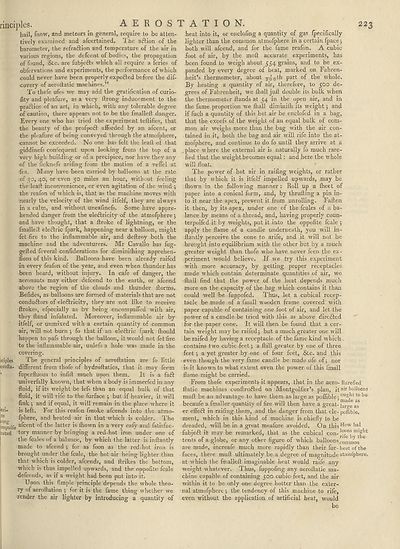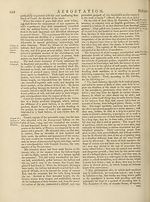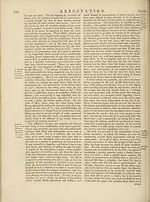Encyclopaedia Britannica, or, a Dictionary of arts, sciences, and miscellaneous literature : enlarged and improved. Illustrated with nearly six hundred engravings > Volume 1, A-AME
(243) Page 223
Download files
Complete book:
Individual page:
Thumbnail gallery: Grid view | List view

223
rinciples. A E R O S
hail, fnow, and meteors in general, require to be atten¬
tively examined and afcertained. 1 he aftion of the
barometer, the refraftion and temperature of the air in
various regions, the defcent of bodies, the propagation
of found, &c. are fubjefts which all require a feries of
obfervations and experiments, the performance of which
could never have been properly expe&ed before the dif-
covery of aeroftatic machines.”
To thefe ufes we may add the gratification of curio-
fity and pleafure, as a very ftrong inducement to the
pra&iee of an art, in which, with any tolerable degree
of caution, there appears not to be the fmalleft danger.
Every one who has tried the experiment tellifies, that
the beauty of the profpedt afforded by an afcent, or
the pleafure of being conveyed through the atmofphere,
cannot be exceeded. No one has felt the lead of that
giddinefs conlequent upon looking from the top of a
very high building or of a precipice, nor have they any
of the ficknefs arifing from the motion of a veffel at
fea. Many have been carried by balloons at the rate
of 30, 40, or even 50 miles an hour, without feeling
the lead inconvenience, or even agitation of the wind ;
the reafon of which is, that as the machine moves with
nearly the velocity of the wind itfelf, they are always
in a calm, and without uneafinefs. Some have appre¬
hended danger from the eleftricity of the atmofphere;
and have thought, that a droke of lightning, or the
fmalled ele&ric fpark, happening near a balloon, might
fet fire to the inflammable air, and dedroy both the
machine and the adventurers. Mr Cavallo has fug-
geded feveral confiderations for diminiddng apprehen-
iions of this kind. Balloons have been already raifed
in every feafon of the year, and even when thunder has
been heard, without injury. In cafe of danger, the
aeronauts may either defeend to the earth, or afeend
above the region of the clouds and thunder dorms.
Befides, as balloons are formed of materials that are not
conductors of eleCtricity, they are not like to receive
drokes, efpecially as by being eneompaiTed with air,
they dand infulated. Moreover, inflammable air by
itfelf, or unmixed with a certain quantity of common
air, will not burn ; fo that if an eleCtric fpark diould
happen to pafs through the balloon, it would not fet fire
to the inflammable air, unlefs a hole was made in the
covering.
The general principles of aerodation are fo little
different from thofe of hydrodatics, that it may feem
fuperfluous to infid much upon them. It is a faCI
univerfally known, that when a body is immerfed in any
fluid, if its weight be lefs than an equal bulk of that
fluid, it will rife to the furface ; but if heavier, it will
fink; and if equal, it will remain in the place where it
is left. For this reafon fmoke afeends into the atmo¬
fphere, and heated air in that which is colder. The
tmpulfe a^cent th® latter is drown in a very eafy and fatisfac-
feated tory manner by bringing a red-hot iron under one of
the feales of a balance, by which the latter is inflantly
made to afeend ; for as foon as the red-hot iron is
brought under the fcale, the hot air being lighter than
that which is colder, afeends, and drikes the bottom,
which is thus impelled upwards, and the oppofite fcale
defeends, as if a weight had been put into it.
Upon this Ample principle depends the whole theo¬
ry of aeroflation ; tor it is the fame thing whether we
render the air lighter by introducing a quantity of
bciples
erofta-
leri.
its
T A T I O N.
heat into it, or enclofing a quantity of gas fpecifically
lighter than the common atmofphere in a certain fpacej
both will afeend, and for the fame reafon. A cubic
foot of air, by the mod accurate experiments, has
been found to weigh about 554 grains, and to be ex¬
panded by every degree of heat, marked on Fahren¬
heit’s thermometer, about part of the whole.
By heating a quantity of air, therefore, to 500 de¬
grees of Fahrenheit, we fliall jud double its bulk when
the thermometer dands at 54 in the open air, and in
the fame proportion we fliall diminifli its weight; and
if fuch a quantity of this hot air be encloftd in a bag,
that the excefs of the weight of an equal bulk of com¬
mon air weighs more than the bag with the air con¬
tained in it, both the bag and air will rife into the at¬
mofphere, and continue to do fo until they arrive at a
place where the external air is naturally fo much rare¬
fied that the weight becomes equal: and here the whole
will float.
The power of hot air in raifing weights, or rather
that by which it is itfelf impelled upwards, may be
ftiown in the following manner : Roll up a (beet of
paper into a conical form, and, by thrufling a pin in¬
to it near the apex, prevent it from unrolling. Faden
it then, by its apex, under one of the feales of a ba¬
lance by means of a thread, and, having properly coun-
terpoifed it by weights, put it into the oppofite fcale j
apply the flame of a candle underneath, you will in¬
flantly perceive the cone to arife, and it will not be
brought into equilibrium with the other but by a much
greater weight than thofe who have never feen the ex¬
periment would believe. If we try this experiment
with more accuracy, by getting proper receptacles
made which contain determinate quantities of air, we
fhall find that the power of the heat depends much
more on the capacity of the bag which contains it than
could well be fuppofed. Thus, let a cubical recep¬
tacle be made of a fmall wooden frame covered with
paper capable of containing one foot of air, and let the
power of a candle be tried with this as above dire6ted
for the paper cone. It will then be found that a cer¬
tain weight may be raifed j but a much greater one will
be raifed by having a receptacle of the fame kind which .
contains two cubic feet j a dill greater by one of three
feet ; a yet greater by one of four feet, &c. and this
even though the very fame candle be made ufe of; nor
is it known to what extent even the power of this fmall
flame might be carried.
From thefe experiments it appears, that in the aero-Rarefied
flatic machines conflrufted on Montgolfier’s plan, it ah baJJoons
mud be an advantage to have them as large as pofliblej^1^11't0^e
becaufe a fmaller quantity of fire will then have a great-
er effeift in raifing them, and the danger from that ele- poffible.
ment, which in this kind of machine is chiefly to be
dreaded, will be in a great meafure avoided. On this ^ow/ haj
fubjeft it may be remarked, that as the cubical con-^n^rn^t
tents of a globe, or any other figure of which balloonscominon ^
are made, increafe much more rapidly than their fur-beat of the
faces, there mud ultimately be a degree of magnitude atindphere*
at which the fmalled imaginable heat would raife any
weight whatever. Thus, fuppofing any aeroflatic ma¬
chine capable of containing 500 cubic feet, and the air
within it to be only one degree hotter than the exter¬
nal atmofphere ; the tendency of this machine to rife,
even without the application of artificial heat, would
be
rinciples. A E R O S
hail, fnow, and meteors in general, require to be atten¬
tively examined and afcertained. 1 he aftion of the
barometer, the refraftion and temperature of the air in
various regions, the defcent of bodies, the propagation
of found, &c. are fubjefts which all require a feries of
obfervations and experiments, the performance of which
could never have been properly expe&ed before the dif-
covery of aeroftatic machines.”
To thefe ufes we may add the gratification of curio-
fity and pleafure, as a very ftrong inducement to the
pra&iee of an art, in which, with any tolerable degree
of caution, there appears not to be the fmalleft danger.
Every one who has tried the experiment tellifies, that
the beauty of the profpedt afforded by an afcent, or
the pleafure of being conveyed through the atmofphere,
cannot be exceeded. No one has felt the lead of that
giddinefs conlequent upon looking from the top of a
very high building or of a precipice, nor have they any
of the ficknefs arifing from the motion of a veffel at
fea. Many have been carried by balloons at the rate
of 30, 40, or even 50 miles an hour, without feeling
the lead inconvenience, or even agitation of the wind ;
the reafon of which is, that as the machine moves with
nearly the velocity of the wind itfelf, they are always
in a calm, and without uneafinefs. Some have appre¬
hended danger from the eleftricity of the atmofphere;
and have thought, that a droke of lightning, or the
fmalled ele&ric fpark, happening near a balloon, might
fet fire to the inflammable air, and dedroy both the
machine and the adventurers. Mr Cavallo has fug-
geded feveral confiderations for diminiddng apprehen-
iions of this kind. Balloons have been already raifed
in every feafon of the year, and even when thunder has
been heard, without injury. In cafe of danger, the
aeronauts may either defeend to the earth, or afeend
above the region of the clouds and thunder dorms.
Befides, as balloons are formed of materials that are not
conductors of eleCtricity, they are not like to receive
drokes, efpecially as by being eneompaiTed with air,
they dand infulated. Moreover, inflammable air by
itfelf, or unmixed with a certain quantity of common
air, will not burn ; fo that if an eleCtric fpark diould
happen to pafs through the balloon, it would not fet fire
to the inflammable air, unlefs a hole was made in the
covering.
The general principles of aerodation are fo little
different from thofe of hydrodatics, that it may feem
fuperfluous to infid much upon them. It is a faCI
univerfally known, that when a body is immerfed in any
fluid, if its weight be lefs than an equal bulk of that
fluid, it will rife to the furface ; but if heavier, it will
fink; and if equal, it will remain in the place where it
is left. For this reafon fmoke afeends into the atmo¬
fphere, and heated air in that which is colder. The
tmpulfe a^cent th® latter is drown in a very eafy and fatisfac-
feated tory manner by bringing a red-hot iron under one of
the feales of a balance, by which the latter is inflantly
made to afeend ; for as foon as the red-hot iron is
brought under the fcale, the hot air being lighter than
that which is colder, afeends, and drikes the bottom,
which is thus impelled upwards, and the oppofite fcale
defeends, as if a weight had been put into it.
Upon this Ample principle depends the whole theo¬
ry of aeroflation ; tor it is the fame thing whether we
render the air lighter by introducing a quantity of
bciples
erofta-
leri.
its
T A T I O N.
heat into it, or enclofing a quantity of gas fpecifically
lighter than the common atmofphere in a certain fpacej
both will afeend, and for the fame reafon. A cubic
foot of air, by the mod accurate experiments, has
been found to weigh about 554 grains, and to be ex¬
panded by every degree of heat, marked on Fahren¬
heit’s thermometer, about part of the whole.
By heating a quantity of air, therefore, to 500 de¬
grees of Fahrenheit, we fliall jud double its bulk when
the thermometer dands at 54 in the open air, and in
the fame proportion we fliall diminifli its weight; and
if fuch a quantity of this hot air be encloftd in a bag,
that the excefs of the weight of an equal bulk of com¬
mon air weighs more than the bag with the air con¬
tained in it, both the bag and air will rife into the at¬
mofphere, and continue to do fo until they arrive at a
place where the external air is naturally fo much rare¬
fied that the weight becomes equal: and here the whole
will float.
The power of hot air in raifing weights, or rather
that by which it is itfelf impelled upwards, may be
ftiown in the following manner : Roll up a (beet of
paper into a conical form, and, by thrufling a pin in¬
to it near the apex, prevent it from unrolling. Faden
it then, by its apex, under one of the feales of a ba¬
lance by means of a thread, and, having properly coun-
terpoifed it by weights, put it into the oppofite fcale j
apply the flame of a candle underneath, you will in¬
flantly perceive the cone to arife, and it will not be
brought into equilibrium with the other but by a much
greater weight than thofe who have never feen the ex¬
periment would believe. If we try this experiment
with more accuracy, by getting proper receptacles
made which contain determinate quantities of air, we
fhall find that the power of the heat depends much
more on the capacity of the bag which contains it than
could well be fuppofed. Thus, let a cubical recep¬
tacle be made of a fmall wooden frame covered with
paper capable of containing one foot of air, and let the
power of a candle be tried with this as above dire6ted
for the paper cone. It will then be found that a cer¬
tain weight may be raifed j but a much greater one will
be raifed by having a receptacle of the fame kind which .
contains two cubic feet j a dill greater by one of three
feet ; a yet greater by one of four feet, &c. and this
even though the very fame candle be made ufe of; nor
is it known to what extent even the power of this fmall
flame might be carried.
From thefe experiments it appears, that in the aero-Rarefied
flatic machines conflrufted on Montgolfier’s plan, it ah baJJoons
mud be an advantage to have them as large as pofliblej^1^11't0^e
becaufe a fmaller quantity of fire will then have a great-
er effeift in raifing them, and the danger from that ele- poffible.
ment, which in this kind of machine is chiefly to be
dreaded, will be in a great meafure avoided. On this ^ow/ haj
fubjeft it may be remarked, that as the cubical con-^n^rn^t
tents of a globe, or any other figure of which balloonscominon ^
are made, increafe much more rapidly than their fur-beat of the
faces, there mud ultimately be a degree of magnitude atindphere*
at which the fmalled imaginable heat would raife any
weight whatever. Thus, fuppofing any aeroflatic ma¬
chine capable of containing 500 cubic feet, and the air
within it to be only one degree hotter than the exter¬
nal atmofphere ; the tendency of this machine to rife,
even without the application of artificial heat, would
be
Set display mode to:
![]() Universal Viewer |
Universal Viewer | ![]() Mirador |
Large image | Transcription
Mirador |
Large image | Transcription
Images and transcriptions on this page, including medium image downloads, may be used under the Creative Commons Attribution 4.0 International Licence unless otherwise stated. ![]()
| Permanent URL | https://digital.nls.uk/193135144 |
|---|
| Attribution and copyright: |
|
|---|
| Description | Ten editions of 'Encyclopaedia Britannica', issued from 1768-1903, in 231 volumes. Originally issued in 100 weekly parts (3 volumes) between 1768 and 1771 by publishers: Colin Macfarquhar and Andrew Bell (Edinburgh); editor: William Smellie: engraver: Andrew Bell. Expanded editions in the 19th century featured more volumes and contributions from leading experts in their fields. Managed and published in Edinburgh up to the 9th edition (25 volumes, from 1875-1889); the 10th edition (1902-1903) re-issued the 9th edition, with 11 supplementary volumes. |
|---|---|
| Additional NLS resources: |
|

